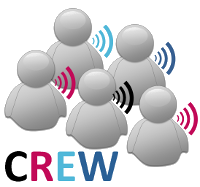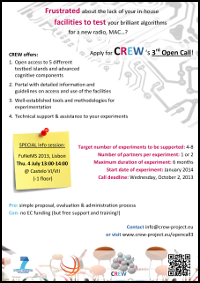FP7 CREW
Cognitive Radio Experimentation World
|
| |
| |
June 2013
|
Dear subscriber,
|
|
The FP7-CREW (Cognitive Research Experimentation World) project is now well into its third year. In this issue of the CREW newsletter, you will find amongst others information about the announcement of our 3rd Open Call at FuNeMS, an overview of the new experiments of the CREW partners that joined the project as a result the second open call, etc .
|
Future Network & Mobile Summit (FuNeMS 2013) - Open Call 3!
|
|
The CREW project organizes three open calls for experimenters in order to
attract more users to the CREW platform and in order to generate
valuable feedback that is used to further optimize the CREW platform.
After two
successful open calls last year, we are happy to announce our third
open call for experimenters. The selected experiments will benefit from extensive support and training by the CREW consortium. Prospective experimenters are invited to
submit proposals before the deadline of Wednesday 2 October, 2013. For more details, please consult the Open Call 3 page.
This
Thursday 4 July at the Future Network &
Mobile Summit in Lisbon, Portugal, more details on the third CREW
open call will be shared. This will take place during a special presentation session in room Castelo VI/VII (-1 floor) from 13:00 till 14:00. After the session, the presentations and other additional information will be made available via the open call section on our website.
While in Lisbon, meet us at our CREW booth at the exhibition, where some of the results of Open Call 2 experiments will be demonstrated.
Go back to the top of the page.
|
Open Call 2 experiments
|
|
In a previous newletter, we already communicated the new partners we've welcomed to the CREW project via our second Open Call. The experimenters aim at following goals and demonstrators:
Experiment-based Validation of Control Channels for Cognitive Radio Systems (by WINGS).
The experiment will result in a demonstration of the functional architecture and of the control channels for the cognitive management of capacity and coverage extensions of the wireless access infrastructures. The demonstration will include: (a) the acquisition of the contextual situation, i.e., the perception of the traffic/mobility/radio conditions; (b) the realization of knowledge-based decisions regarding the creation/maintenance of the optimal feasible construct that will extend the infrastructure; (c) the creation of knowledge regarding context handling.
The Wireless MAC Processor over CREW: enabling Cognitive Access Benchmarking (by CNIT).
The goal of this experiment is showing that the Wireless MAC Processor architecture allows to support the definition of self-adapting access mechanisms, able to switch from standard DCF to a TDMA-like access scheme in case of hidden nodes. Starting from a "legacy" multi-hop network topology, configured on the wiLab testbed, with all nodes communicating using standard DCF, we create a traffic scenario where some nodes suffer the known "flow-in-the-middle" phenomenon which degrades performance due to excessive neighbours overhearing. We hence demonstrate an effective control architecture that i) detects the situation, ii) advertises involved nodes with new self-synchronizing MAC algorithms which does not suffer the fairness problem; iii) programs nodes to switch to the newly advertised MAC algorithms. A demonstrator will provide insight in how to program a TDMA-like MAC using our graphical tools, and how to integrate new self-adapting MACs into the control infrastructure.
Online Monitoring of Spectrum Sensing Delay and Energy Consumption in the CREW Benchmarking Framework (by UTH and NICTA).
This experiment will demonstrate how the use of the NITOS Advanced Chassis Manager (ACM) card aids in the energy efficiency evaluation of Spectrum Sensing platforms and algorithms. We will attach the NITOS ACM card to an adapter custom developed to provide for connectivity with the IMEC Sensing Engine (SE). Through real-time demonstration we will present how varying settings configured in the IMEC SE (varying FFT size, application of different sensing algorithms, FPGA-based or host-based processing), impact the overall energy consumption of the platform. The gathered measurements will be presented through a GUI that will illustrate the instantaneous power consumption along with the experiment execution, as well as the total energy expenditure that each different scenario corresponds to.
Experimental coexistence study in TV bands (by IT and CMSF).
The main objectives of this experiment is to explore how the CREW federation working in synergy with the new elements implemented under this action, can be used to investigate new coexistence scenarios in TV bands. In particular, we are interested to carry out a trial to assess the benefits of combining a TV white spaces database with a distributed sensing network in the coexistence between incumbent and cognitive radio systems.
The experiment will explore and make use of two CREW facilities: the JSI’s distributed sensor network in the Logatec area and the IRIS software defined radios provided by TCD.
Go back to the top of the page.
|
Successful demos at FIA Dublin
|
|
At the Future Internet Assembly (FIA) in Dublin on 8-10 May 2013, the final results of the Open Call 1 experiments were demonstrated, as well as some experiments of the core partners. You were unable to attend? No worries, you can still watch these demos online.
1./ Building a radio environment map for tracking a moving interfering robot (by iMinds and imec). Coexistence of wireless technologies (Wi-Fi, Bluetooth, ZigBee...) in ISM bands is hard, because different technologies are interfering with each other. To improve coexistence devices should be capable to detect co-located interferers, which can be mobile devices moving around. By using distributed spectrum sensing device at different nearby locations, a radio environment map (REM) can be created showing the spatial spectrum occupation. This demo shows a moving robot, which generates interference, that is sensed by advanced distributed spectrum sensing devices (both common USRP and proprietary imec) and visualized in a REM.
2./ Handover on the Iris software radio platform (by Trinity College Dublin). This demonstration showcases the capabilities of the Iris software radio platform with an implementation of handover with continuous service between two independent base-station entities belonging to different operators. The handover occurs without any link layer connection between the base-stations and without prior knowledge of base-station operating frequencies or channelization on the part of the receiver. For this to work the receiver must be a cognitive receiver, i.e. a cognitive radio device that intelligently determines the frequencies at which the target base station is operating on, and execute the handover itself. The implementation consists of three radios, two transmitters and a cognitive receiver, all of which are full radio chains that have been implemented completely with the Iris software radio platform.
3./ Device sensitivity and environment measurements (by University of Durham). Cognitive radio (CR) relies on sensing its environment to identify unoccupied frequencies. The success of CR depends on the sensitivity of the used devices to detect the primary user, and the environment which can cause the signal to be undetectable due to either blockage by buildings or terrain or due to the presence of multiple paths connecting the transmitter to the receiver. To avoid causing interference to the primary user, the experiments at Durham University tested several devices to identify their sensitivity and measured three environments: the air cabin at EADS, TUB and iMinds.
4./ CCA agent in a CSMA MAC using Iris (by Technische Universitat Ilmenau). This demonstration showcases the integration of the imec sensing engine (SE) as a clear channel assessment (CCA) agent into a carrier sense multiple access (CSMA) based medium access control (MAC) protocol implemented on the basis of Iris. In particular, the demo shows how the MAC, in conjunction with the SE, coordinates access to the shared medium and allows a live video conference over the system.
5./ Collaborative spectrum sensing (by Tecnalia). The demonstration shows a limited example of collaborative spectrum sensing, i.e. information of different sensors at different locations is integrated to have a picture of the spectrum occupation. Measurements from the different sensors are integrated through different algorithms in order to feed a data base of spectrum occupation. Users on a dynamic spectrum access system could connect to this data base and know which frequency bands are already occupied and which are free and could therefore be employed by them. Different CREW testbed facilities have been mixed in order to build this system.
Go back to the top of the page.
|
The CREW Training Days:
a story to be continued
|
|
On 19-20 February 2013, the first CREW Training Days took place in Brussels. They provided a lot of information and hands-on testing of the different facilities within the CREW federation. Presentations and tutorials are still available online. We thank the different attendees for their interest and their cooperation during these days! The collected feedback revealed that the vast majority found these training days very useful. Therefore, a second edition is planned early 2014, which will be especially very useful for new Open Call 3 experimenters.
Go back to the top of the page.
|
Other news
|
|
Recently, new deliverables were added to the documents section of the CREW website.
At the European Conference on Wireless Sensor Networks (EWSN), the Best Demo Award 2013 went to M. Chwalisz, J.-H. Hauer, J. Büsch and V. Handziski for their demo “An Infrastructure for Automated BAN Experimentation”. Congrats to the authors!
Instituto de Telecomunicações - Portugal, one of the OC2 parter of CREW, was invited to participate in a workshop organized by Microsoft. The event, called "Dynamic Spectrum Sharing: The Future of Wi-Fi & the Internet of Things" was held in Berlin, in April 9, 2013.
Rogério Dionísio presented the results of COGEU TVWS trials in Munich, and explained the implications of the secondary use of TVWS for rural broadband and M2M communications. On behalf of the OC2 CREW-TV project, he described the geolocation database to be created in Slovenia, and explained infrastructure sensing of PMSE devices using Joseph Stefan Institute (JSI) testbed.
The audience was composed by representatives of the industry (Microsoft, Neul, FairSpectrum), universities (Cambridge) and European entities (ECO, CEPT), among many others.
We look also forward to meeting you at an upcoming conference or event.
Best regards,
The CREW project
Go back to the top of the page.
|
|
|
|
|

